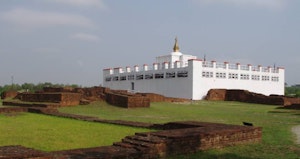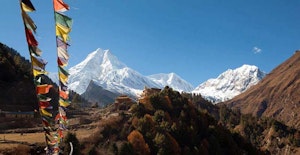Rising 8,848 meters out of the Himalaya, Mt. Everest, also known as Sagarmatha, is the tallest mountain in the world. It has long stood as a symbol of mountaineering and rugged wonder, helping shape the communities and cultures of Nepal, Tibet, India, and beyond. The remote location, sustained approach, and raw beauty of its geography and geology make this larger than life legend worth visiting at least once in a lifetime. One of the best ways to do so is via the Everest Base Camp Trek in Nepal.
This extraordinary 130-kilometer excursion into the heart of the Himalaya is a two week (or more) immersion into a unique part of the world. The trip itself blends aesthetic pleasure with inspiring challenges across for a rewarding trek unlike any other. Sagarmatha National Park and the entire Khumbu region are rife with natural splendor, including Himalaya gorges, fir and blue pine forests, and rare animals like the snow leopard and musk deer.
Following the Dudh Kosi and Imja Khola Rivers deep into the Himalaya will expand your views of how beautiful Nepal can be. Traveling into the unadulterated wilderness surrounding the world’s tallest peak is a manageable option for anyone who wants to admire this part of the world, even taking into account the steep and rocky terrain.
The Everest Base Camp Trek is a profound mountain experience without having to navigate the daunting and perilous pathways to the summit of Everest. Grab a guide and take off on your phenomenal adventure to see first hand the astounding beauty and immensity of this natural heaven on Earth.

Three Reasons to Do the Everest Base Camp Trek
1| Awe-Inspiring Scenery
During your expedition, you will come face to face with Himalaya heavy-hitters like Ama Dablam, Cho Oyu, Lhotse, Lobuche, and – of course – Sagarmatha. If daunting mountain peaks weren’t enough, you will follow winding rivers through the Khumbu Valley accompanied by fields of flowers. If you’re lucky enough to visit in the spring, you may just witness blooming rhododendrons.
The small villages also play into the regional aesthetics and profundity of your journey. Stone buildings with colorful roofs peer out over jagged cliffs and into the clouds. There is nothing but atmosphere and space between you and the highest mountains in the world. The evocative panoramas that riddle the landscape at every step of the way will undoubtedly move you.
2| Exhilarating Challenge
It wouldn’t be the same experience if you could easily walk to the foot of these rocky juggernauts! No adventure is complete without a little sweat and a few tears. But that’s part of the fun! You get to test your limits in a beautiful setting, hiking along meandering trails up and down an unusual wilderness. Fourteen days to complete a goal is hard, but it is something you can definitely do.
The Everest Base Camp Trek is not a technical climb or ascent. It involves a healthy portion of walking and hiking, at times steep and difficult, but never too hard to complete. People of all ages and sizes are capable of finishing the course with a smile on their face. In fact, you will most likely pass a multitude of hikers and trekkers who fill every part of the spectrum. Embrace the challenge and have a blast!

3| Himalaya Culture
The Sherpa communities of Nepal are part of the trek. Seeing entire mountain villages dedicated to tourists and mountain sports may be shocking, but it also helps appreciate the process. The people of Nepal are incredible kind and generous, and sharing an experience like this with native Sherpa families can outshine the trekking aspect of the journey.
You will have the opportunity to visit sacred monasteries in a few different villages along the way. Take advantage of these cultural enrichment trips. Namche Bazaar is one of these hubs that even has multiple museums to learn about the history and development of mountaineering in Nepal. Understanding the direct positive impact your journey has on the local way of life is powerful and will surely keep you focused on the goal of reaching Everest Base Camp.
Starting Point
The Everest Base Camp Trek begins with a flight to the Lukla Airport from Kathmandu, the capital of Nepal. This local flight is not particularly long, but it may test your patience as you maneuver through the mountains to the short runway of at Lukla. This small airport on a steep mountainside offers the first of many outstanding views.

Your trip can include multiple days in Kathmandu. This will help to settle in and physically acclimatize to the mountains, which is a great opportunity to learn about the culture of Nepal and its people. The actual trek will begin from Lukla when you hike to the ensuing villages of Chheplung and Phakding. Your initial days in the capital should be considered part of the adventure.
Itinerary / Duration
The day-by-day hiking itinerary is up for debate because it can be completed at various paces. Generally speaking, the Everest Base Camp Trek is completed in about 14 days, but many programs will take longer – you can expect to find trips of 20 days or more. This is because of acclimatization and cultural inclusions that will ultimately enhance your trip, so extra days should be considered an appropriate addition to any excursion.
On a basic 14-day journey, participants can expect to arrive in Kathmandu for a day of settling in a preparing. Resting, checking the equipment, and going over any last-minute itinerary changes can be done here, as well as visiting museums and participating in cultural activities.
The actual trekking will begin on the second day upon arrival to Lukla. Once on the trail, trekkers follow small bridges and trails past enchanting villages with deep Buddhist roots. One of the highlights is Namche Bazaar, the main trading hub along the route. Pick up supplies, stop by one of the two museums, or just enjoy local fare while acclimatizing to the environment.

As the trail continues, Ama Dablam comes into view and dominates the skyline. The Kosi River winds with the path as travelers make their way into the mountains from which it flows. The natural setting features an array of bird life (among other fascinating wildlife), including the Himalaya monal and different species of chough.
As the trail nears its final destination, the cultural gems of higher villages present themselves. Pangboche is home to a significant monastery, located in a swath of trees on an astounding mountainside. A quick respite can center a trek and enhance the serene aspects of such an exciting journey.
After an eight to ten day approach, the trek culminates at Gorakshep (5,180m) and Everest Base Camp at 5,364 meters. A push to Kala Patthar and its viewing point will reveal amazing vistas of Mt. Everest and its surrounding neighbors. Clouds will be floating between the peaks, adding to the sensation that this is the top of the world.

The standard return along the approach route takes roughly four days includes another rest day in Kathmandu for any final sightseeing or day trips. Additional return routes to Lukla and Kathmandu may present themselves at this point in the excursion as an alternative to following the return route to Lukla and Kathmandu.
The less-traveled Cho La Trail descends into the Gokyo Valley for an in depth appreciation of the pristine lakes and scenery of the region. This allows an escape from the crowds of the traditional hiking path. The Gokyo Lakes are considered one of the most beautiful parts of the region, so adding them to the itinerary is sure to be well worth it.
Keep in mind that there are plenty of alternatives to this itinerary. This 20-day program that takes you through the aforementioned Gokyo Valley is a more relaxed hike, providing a different perspective to the epic beauty of the region surrounding Everest.

How Hard is the Everest Base Camp Trek? How to Prepare
The Everest Base Camp Trek is definitely a daunting trek, but you don’t have to be a world-class athlete to complete it successfully. You should be in good to great shape, prepared both physically and mentally for five to six hours of hiking a day. The technical aspects of the trek may not be substantial, but the sustained activity will certainly take its toll. Previous hiking, trekking, and mountaineering experience is recommended and is a strong asset to any undertaking of this expedition.
Exercising regularly before embarking on the journey is highly advised. If you can get to the point where you are comfortable walking with a backpack for six, you will be able to appreciate this trek. Your fitness level can directly affect how enjoyable the trip is, so it can’t hurt to initiate a training program to reach this level. Hiking around trails near you a couple months before the trip, slowly building up to five and six hour hikes, will do wonders.
Remember that acclimatization can also have an adverse effect on the trek. Plan for enough days to get used to the thin air and atmosphere at altitude in the Himalaya. You cannot train for altitude sickness, so taking extra time to rest and get used to the elevated environment is a precaution that will improve your chances of success.
How Much Does It Cost?
The two week or more journey to the base of the world’s tallest mountain is no easy feat, but it doesn’t have to break the bank. A traditional 14-day Everest Base Camp Trek program starts around $1,425 (USD), and includes accommodation, half-board meals, in-program transportation and transport, and park permits.

The cost will depend on your group size, the duration, and what is included, so expedited trips like this 12-day Everest Base Camp Trek begin at $730. For longer, more inclusive adventures, like this 18-day Everest Base Camp Trek that includes Lobuche Peak, you can expect prices beginning around $3,300 per person for a group of three.
What is the Best Time to Go?
To avoid monsoon season and inclement weather, planning a trip from March to May and September to mid-November is your best bet for favorable conditions. Winters are cold and snowy, and volatile weather is common at such high altitudes. By contrast, the summers can be hot, humid, and uncomfortable, with some of the spectacular views you came to see getting lost in the clouds.
Trips in spring will have the added bonus of blooming flora, notably the vivid colors of the iconic Khumbu Valley rhododendrons. This spectacle may come at a price because dusty trails can complicate the trek. For autumn adventurers, the summer monsoons will have cleared the air to allow for arguable the best views in the Himalaya.

How to Get There?
Getting to the starting point of the Everest Base Camp Trek always includes a flight to and from Kathmandu. Luckily, it is a regional hub with many flights and seamless access to the Nepalese countryside. Tribhuvan International Airport (TIA) is the major airport in the capital and connects directly to Dubai, Istanbul, New Delhi, Singapore, Doha, and Chengdu.
Turkish Airlines, Qatar Airways, and Air India are just some of the airlines that take you into Kathmandu. Yeti Airlines, Buddha Air, and Nepal Airlines all offer domestic flights in Nepal.
Traveling by bus is not necessary for this trek, though it can be a scenic alternative for a side trip. Be aware that transportation may be crowded and uncomfortable. Perhaps a small price to pay for a fulfilling and intriguing experience into the heart of Nepal’s remarkable countryside.
So what are you waiting for? Sign up for the ultimate hiking adventure NOW by booking your Everest Base Camp Trek in Nepal and head to the top of the world and the incomparable wilderness and wildlife surrounding Sagarmatha!







